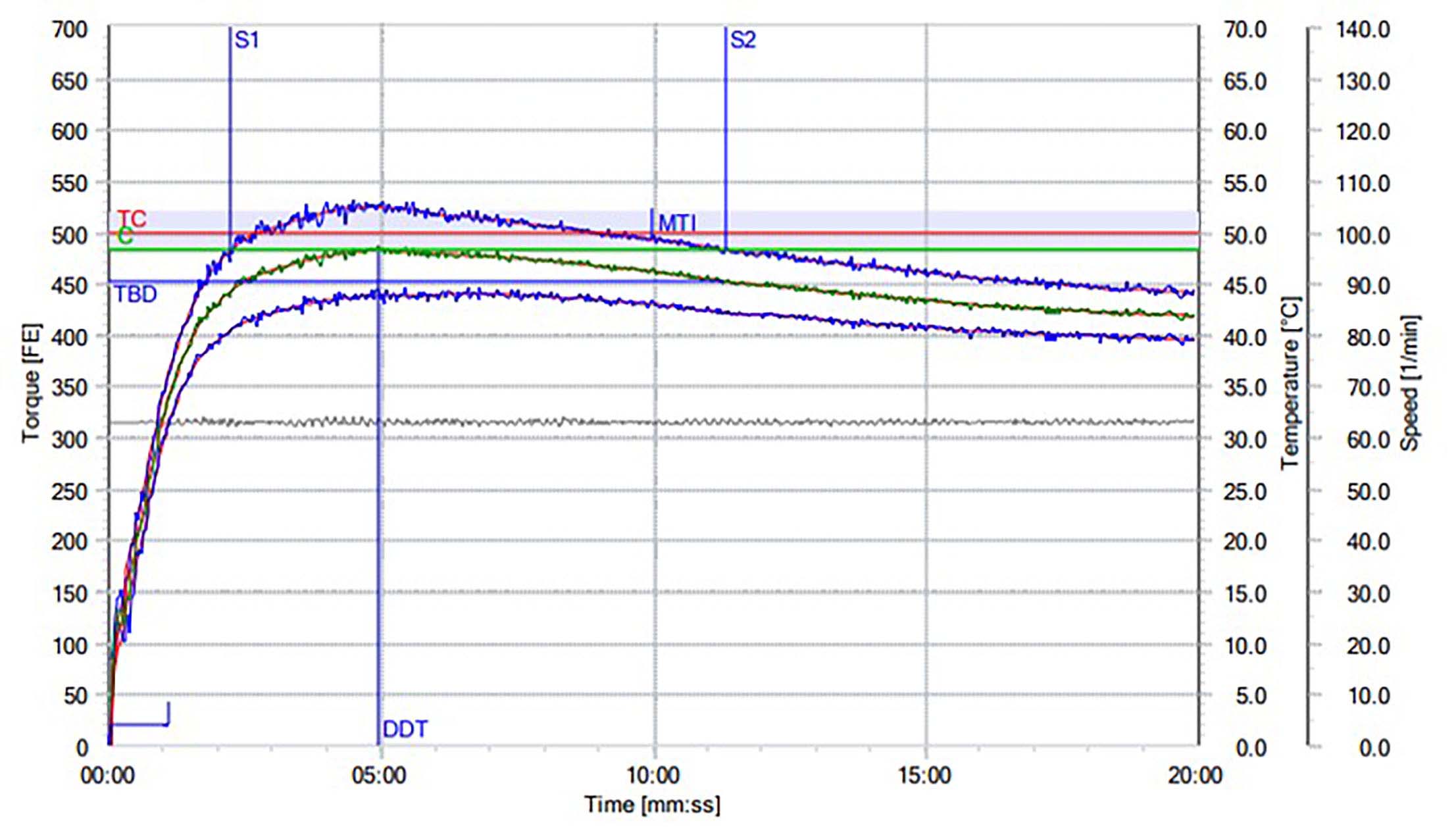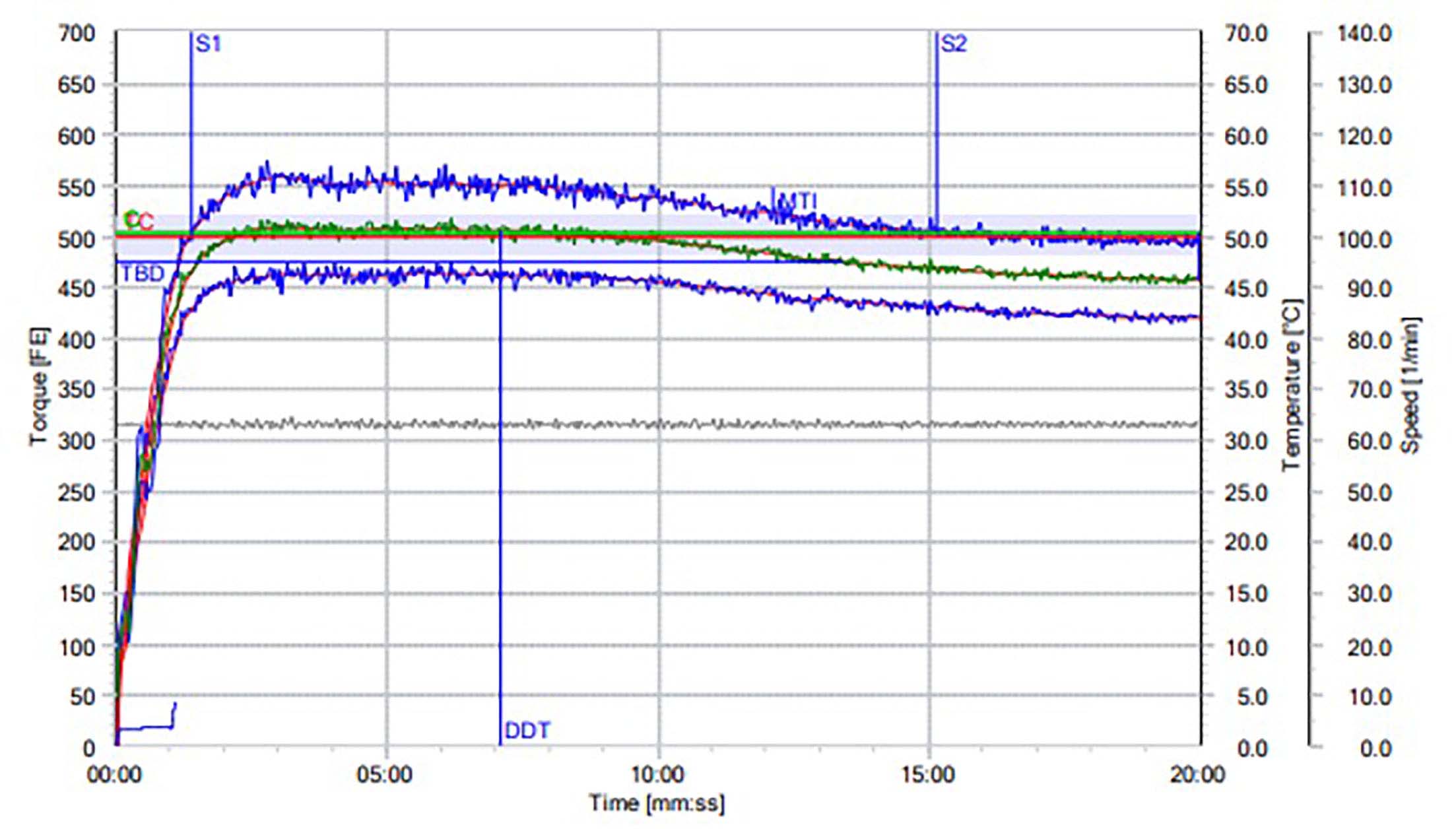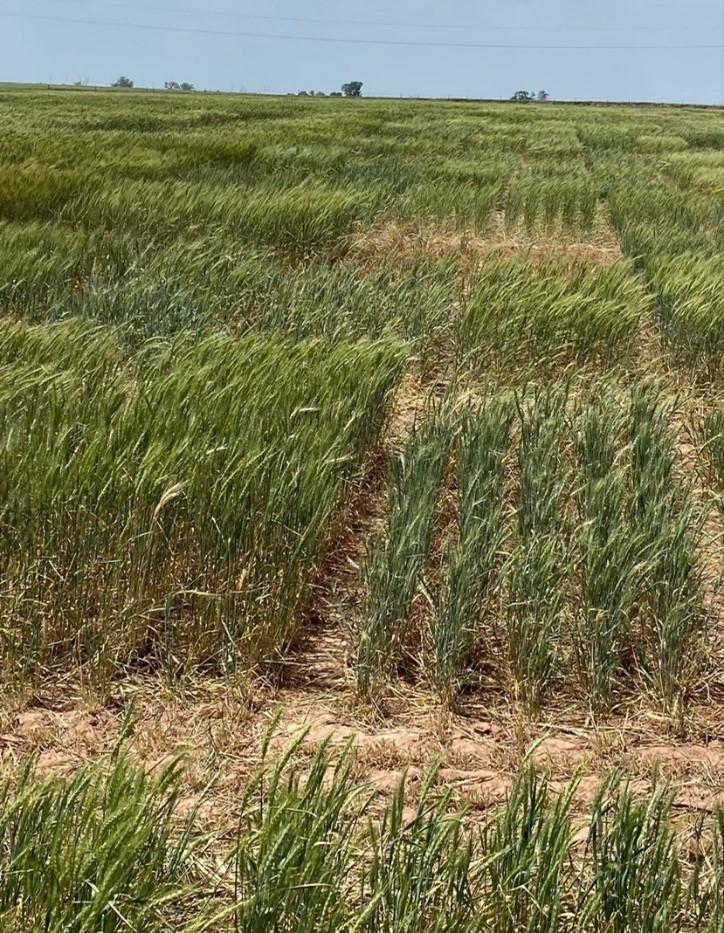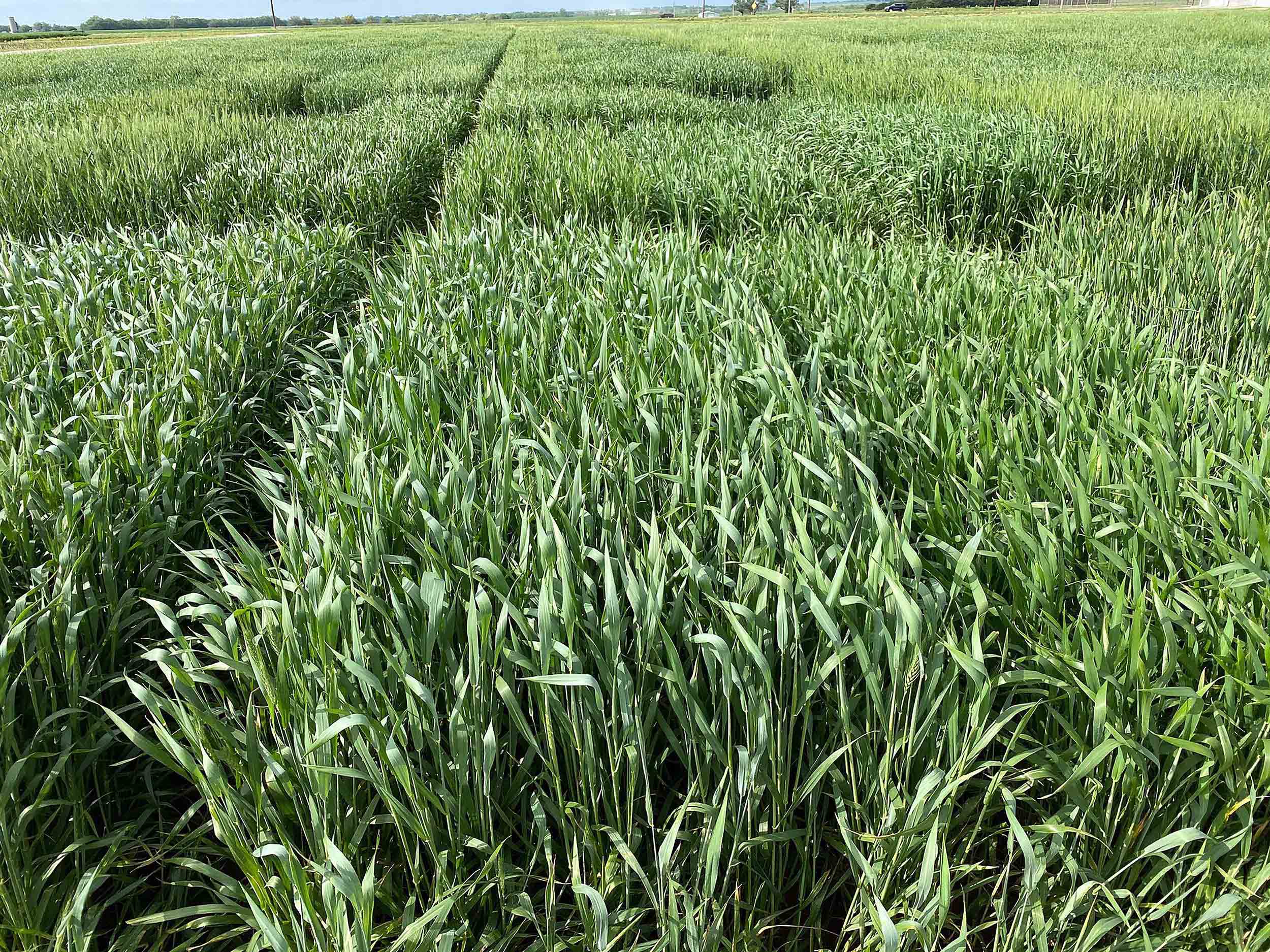Wheat Variety Development 2024
OSU Set to Release Major Clearfield Wheat Variety
With only sporadic releases of OSU Clearfield (CL) wheat varieties in 2013 (Doublestop CL Plus) and 2020 (Strad CL Plus), the time was ripe for an upgrade. Given the popularity of Doublestop CL Plus with Oklahoma and south-central Kansas wheat producers, it made sense to upgrade Doublestop CL Plus genetics. Clearfield Plus wheat varieties provide two-gene herbicide tolerance to the annual grass control herbicide, imazamox, which is sold under the trade name Beyond.
The candidate variety is experimentally named OK198417C. It was tested statewide in replicated yield trials for six years, starting in 2019. Data points are not lacking for this candidate, and confidence is high among Oklahoma State University Wheat Improvement Team members Brett Carver, Amanda Silva and Meriem Aoun that OK198417C is well adapted to the various climate conditions and pest pressures of Oklahoma.
The closest relatives of OK198417C are also Beyond-resistant varieties (Figure 1). OK198417C is about two-thirds (66%) Doublestop CL Plus. Two full siblings from the cross of two inbred wheat varieties would be 50% related, so this degree of relationship to Doublestop CL Plus is relatively high.
Figure 1. The genealogy of OK198417C extends back three generations or breeding cycles.
Aside from the Beyond resistance gene donors identified in Figure 1 as AHAS, ancestors to OK198417C include the OSU wheat varieties 2174 and Intrada, plus TAM 110 from Texas A&M University and Jagger from Kansas State University. All these varieties are considered great-grandparents to OK198417C.
Across 42 site-years (no fungicide) from 2019 to 2024, OK198417C exceeded Doublestop CL Plus in yield by nearly 15%, while its test weight across 23 site-years was equal to or slightly better than that of Doublestop CL Plus. This is an extremely rare trait combination inside or outside of the Clearfield genetic pipeline. Surpassing the yield of Doublestop CL Plus alone is not so extraordinary, but coupling this yield advantage with a comparable or slightly higher test weight will be difficult to repeat. Wheat protein concentration of OK198417C is considered high and only slightly below that of Doublestop CL Plus across 10 site-years. A long-term mean of 12.9% still puts OK198417C in high cotton for wheat protein.
Figure 2. Mean grain yield, test weight and wheat protein concentration of OK198417C across n site years and as a percent of Doublestop CL Plus (percent in white) in replicated breeding nurseries from 2019 to 2024.
In Oklahoma and Washington, where stripe rust infections can be catastrophic, OK198417C has displayed developmentally earlier and stronger resistance than >95% of the elite germplasm in the OSU wheat variety development pipeline. This is perhaps the greatest virtue of OK198417C – its ability to fight off infection in multiple environments differing in inoculum load or timing of infection, beginning with stem extension.
In no region was this more obvious than southwestern Oklahoma in 2024. Canopy hygiene differences in Figure 3 in late March were directly proportional to final yield 10 weeks later.
Figure 3. Wheat breeding trial plots of Doublestop CL Plus (left) and OK198417C (right) at the Tipton Research Station on March 31, 2024. The canopy chlorosis is already showing on Doublestop CL Plus because of a relatively early infection of stripe rust. Plots in the background exhibit even greater, and eventually lethal, chlorosis. Grain yields of these two plots were 21 bu/ac (Doublestop CL Plus) and 48 bu/ac (OK198417C).
WIT scientists hesitate to call this all-season resistance because seedling assays of OK198417C reveal susceptibility. Nevertheless, this stripe rust resistance package – which only OK Corral can come close to – is robust and currently highly reliable and far superior to that of Showdown, High Cotton and Doublestop CL Plus. Stripe rust resistance in OK198417C is best described as being expressed in the adult plant but without the high-temperature dependency to trigger its expression more commonly found in varieties with high-temperature adult-plant (HTAP) resistance.
For leaf rust, OK198417C has consistently exhibited novel, strong leaf rust resistance under natural field infection and with controlled inoculations dating back to 2019. This pattern response was corroborated by Meriem Aoun in 2024 in a leaf rust nursery in Stillwater in early to mid-May.
Unlike its stripe rust reaction, however, some exceptions were noted for the first time late in crop development in 2024 (by Aoun) in Stillwater and Caldwell, Kansas (by Jeff Wright). Controlled-environment seedling assays were quickly conducted by Aoun in
December 2024, using a bulk of leaf rust isolates collected in Oklahoma in the 2024 crop year, to test the hypothesis that a new leaf rust race(s) emerged later in the 2024 season. OK198417C exhibited a mixture of resistant and susceptible reactions on the same leaves, indicating that new isolates with virulence were present in this Oklahoma bulk population.
Hence, OK198417C appears to offer significant improvement over Doublestop CL Plus, and possibly over Strad CL Plus, for protection against leaf rust, but this protection may collapse depending upon the race composition of the existing pathogen and the apparent race-specific leaf rust resistance of OK198417C. This bears monitoring in future trials.
These reactions to stripe rust and leaf rust are summarized in Figure 4, along with several other disease reactions and agronomic characteristics. Potential weaknesses of OK198417C include a variable reaction to barley yellow dwarf (moderately susceptible at worst, depending on virus intensity) and a moderately susceptible reaction to the wheat soilborne mosaic/wheat spindle streak mosaic complex.
OK198417C has exhibited a susceptible reaction to Hessian fly in greenhouse tests, but field reactions by WIT scientist Kris Giles in the natural presence of Hessian fly indicated a resistant reaction. Additional field trials are needed to clarify this discrepancy, which is common in OSU germplasm. Not depicted in this chart due to insufficient data is the reaction to Bacterial streak. Only one incident was observed in Morris in 2020, which indicated a possible susceptible reaction.
Figure 4. Agronomic and quality characteristics of greatest relevance to Oklahoma.
Milling quality of OK198417C is exceptional based on a kernel size slightly smaller and test weight no less than that of Doublestop CL Plus. However, baking quality is only average due to an estimated 30% reduction in mixing tolerance relative to Doublestop CL Plus (Figure 5). Flour protein concentration and water absorption of OK198417C are above average for hard red winter wheat, whereas, dough development peak time, stability time and mixing time index are about average or slightly below the industry standard.
Figure 5. Representative farinograph curves generated from OK198417C (top) and Doublestop CL Plus (bottom) white flour samples by Grain Craft, and a three-year summary of common farinograph parameters averaged across four site-years for each variety tested in side-by-side field plots.
| Entry | Flour protein % |
Absorption % |
Peak time min |
Stability time min |
MTI BU |
|---|---|---|---|---|---|
| OK198417C | 12.4 | 61 | 6 | 9 | 39 |
| Doublestop | 13.2 | 63 | 8 | 15 | 25 |
The pending commercialization of OK198417C denotes the withdrawal of WIT’s past pursuit of two Doublestop CL Plus-derived candidates without the BASF trait for herbicide tolerance. These were experimentally named OK16107133-19-3 and OK16107133-19-4 and were ready for a commercial launch in 2025. Excellence in stripe rust resistance, Hessian fly resistance and grazing tolerance notwithstanding, their 2-pound test weight disadvantage, yield inconsistency, and milling and baking inferiority to OK198417C justifies this decision.
OSU CoAXium Wheat Remains on Schedule
Thirty-one elite hard red winter CoAXium lines were extensively tested in 2024. Their value to Oklahoma is enhanced by previously showing resistance to leaf rust, barley yellow dwarf or Hessian fly. CoAXium varieties currently available do not commonly feature these traits.
With exposure to severe stripe rust pressure during 2024 field testing, these 31 candidates were filtered down to just six elite lines and placed under foundation seed increase by Oklahoma Foundation Seed Stocks in fall 2024. Common OSU wheat varieties present in their pedigrees include Baker’s Ann, Uncharted and Smith’s Gold, plus other commonly utilized OSU experimental lines (Table 1).
| Entry | Pedigree | Key Traits |
|---|---|---|
| OK23D89031X | Incline AX (AD)/2*OK12621 | Best disease package |
| OK23D89037X | Incline AX (AD)/2*OK12621 | Backup to 031X, inferior quality |
| OK23D89055X | T158+AB/OK188608//Smith's Gold | Short-season, straw strength? |
| OK23D89076X | T158+AB/OK188608//OK12D22004-016 | Highest yield, interm. YR/LR |
| OK23D89082X | T158+AB/OK188608//Baker’s Ann | Best overall package |
| OK23D890129X | T158+AB Uncharted//Baker's Ann | Best for dual-purpose, YR susc. |
One lesson repeatedly learned in 2024 was that Aggressor application at above-optimal rates must occur earlier rather than later and certainly before aboveground stem extension can be readily observed or at early jointing stages. Aggressor applications on breeding nurseries were intentionally at twice the commercial rate, with MSO adjuvant and without a crop safener.
All of this becomes even more important in a grazed environment. One of WIT’s most successful CoAXium breeding nurseries in 2024 was a dual-purpose grazed site near Okarche where differences in tolerance were easily detected, even when the genetic data indicated two genes for herbicide tolerance were present throughout (Figure 6). Hence, other genes could modify expression of those specifically targeted and marketed under the AXigen trait name. Further research is needed to adequately test this hypothesis.
Figure 6. OSU wheat breeding nursery at a grazed site near Okarche on April 30, 2024, or about five weeks post-application of 2x Aggressor + MSO. Differences in height, development (lateness) or stand indicate different degrees of herbicide tolerance. Herbicide damage or intolerance was expressed at harvest (not shown) as lodging at the base of the plant, akin to a kind of root rot. This was also observed on some check varieties.
On the Wellness Wheat Front
Only red, white and amber bran color provide the seed choices for wheat producers, and thus, the supply chain for wheat end-users and consumers. Purple-pericarp or purple bran wheat comes naturally biofortified with anthocyanins, flavonoid compounds with unique antioxidant and anti-inflammatory activity commonly found in colored fruits and vegetables. Antioxidants protect cells from oxidative stress (i.e., cell damage)
caused by highly unstable free radical compounds. Cumulative damage with natural aging can contribute to chronic diseases like cancer and heart disease.
Red and white wheat types do contain some anthocyanins but at very low concentrations. Purple wheat can provide human health benefits when consumed in whole wheat food products or by de-branning, a milling process that allows recovery of bran-origin bioactive compounds for use in naturally enriched food products or as a natural food colorant.
Purple wheat germplasm produced by WIT contains all six major anthocyanin compounds found in fruits and vegetables. One purple bran elite line targeted for commercialization in 2025 is experimentally named OK21DTR1720-92, which was mostly derived from OSU varieties Big Country and Smith’s Gold. One strategy might be to provide anthocyanins prevalent in wheat but less prevalent in fruits and vegetables. Currently, the strategy is to elevate the total anthocyanin contribution of wheat grain with the limited germplasm available.
Other results thus far can be summarized as follows:
- Total anthocyanin concentration of OK21DTR1720-92 exceeds the HRW check of Smith’s Gold by three-fold.
- The anthocyanin concentration in OK21DTR1720-92 of whole meal flour can reach 25 μg/g. The functionality of this line for bread baking has been deemed excellent by industry cooperators.
- Preliminary analysis indicates the total anthocyanin concentration in fully baked
purple wheat bread (<100% whole wheat) falls in the following range of other common
food sources of anthocyanins:
- Blackberry (uncooked) >> Purple corn chips > OK21DTR1720-92 bread > canned black beans
- More research is needed to determine the quantity of anthocyanins lost during weathering in the field before harvest and during processing or baking. WIT will have more to share as a graduate student project dedicated to this subject area is completed in 2025-26.
Figure 7a. OSU experimental line OK21DTR1720-92 in a research trial at Lahoma in 2021.
Figure 7b. Near-mature spike of OK21DTR1720-92 in the greenhouse (right).
Increasing WIT’s Presence and Impact in the Panhandle
Including a reliable dryland testing site at Balko in 2023 continues to have a huge impact on the OSU wheat research program dedicated to the Oklahoma Panhandle. This wheat acreage requires special attention that cannot be addressed by simple osmosis of the germplasm targeted downstate.
Adaptation downstate in the central wheat corridor does not necessarily equate with adaptation upstate in the panhandle. There have been exceptions, such as Showdown, Bentley and a few other varieties preceding those.
However, healthy competition from other public or private wheat breeding programs that could service this region dictates this simple rule: to breed for specific adaptation to the panhandle with a focus on the wheat streak mosaic/Triticum mosaic virus complex more prevalent in this region.
Four elite experimental lines (Table 2) were placed under foundation seed increase in fall 2024 and represent the most likely candidates for targeted release and positioning in the Oklahoma Panhandle.
| Experimental Line | WSM/TM resistance (0-5)* | Putative genes for resistance | Relative yield (dryland)* |
|---|---|---|---|
| OK2089183 | 2 | Cmc4 | 4 |
| OK21PS825 | 4 | Cmc4, Wsm1 | 3 |
| OK20D78S021 | 3 | Cmc4, Wsm1? | 4 |
| OK22838 | 5 | Cmc4, Wsm1 | 3 |
* 0 = no resistance or well below-average yield; 5 = maximum resistance or maximum yield currently in HRW wheat. A resistance level of 2 may be more than sufficient with lighter disease pressure.









